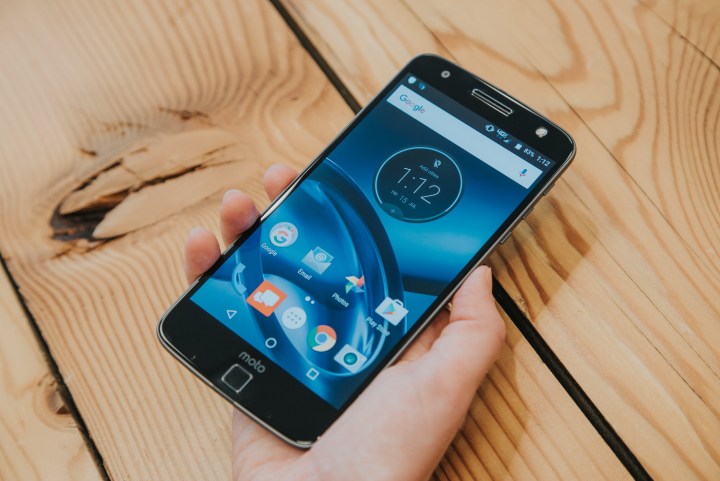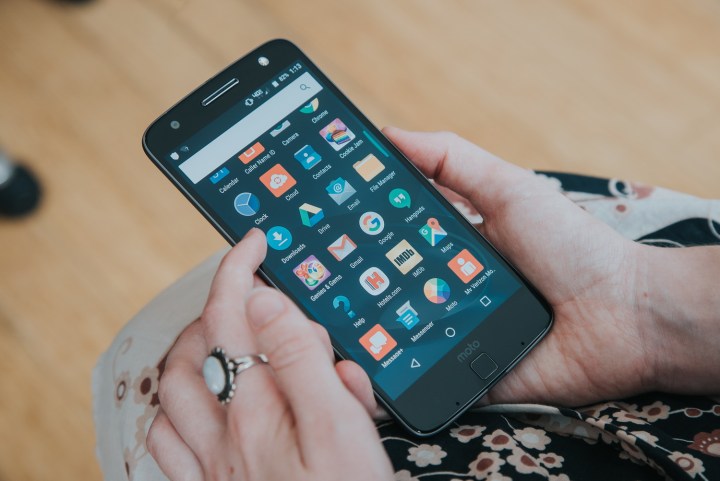
Specs and performance
| Lenovo Moto Z2 Force
|
Lenovo Moto Z Force
|
|
| Size | 155.8 x 76 x 6.1mm (6.13 x 3 x 0.24 in) | 155.9 x 75.8 x 6.99mm (6.14 x 2.98 x 0.28 in) |
| Weight | 5.04 ounces (143 grams) | 5.75 ounces (163 grams) |
| Screen | 5.5-inch Quad HD Super AMOLED P-OLED touchscreen | 5.5-inch Quad HD Super AMOLED P-OLED touchscreen |
| Resolution | 1,440 x 2,560 (538ppi) | 1,440 x 2,560 (538ppi) |
| OS | Android 7.1.1 | Android 7.0 Nougat |
| Storage | 64GB (U.S.) 128GB (International) | 32GB/64GB |
| MicroSD card slot | Yes | Yes |
| NFC support | Yes | Yes |
| Processor | Qualcomm Snapdragon 835 | Qualcomm Snapdragon 820 |
| RAM | 4GB (U.S.) 6GB (International) | 4GB |
| Connectivity | 4G LTE, GSM, CDMA, HSPA+, 802.11a/b/g/n/ac Wi-Fi | 4G LTE, GSM, CDMA, HSPA+, 802.11a/b/g/n/ac Wi-Fi |
| Camera | Dual 12MP rear, 5MP front | 21MP rear with OIS, 5MP front |
| Video | 4K | 4K |
| Bluetooth | Yes, version 4.2 (update to Bluetooth 5 coming with Android 8.0) | Yes, version 4.2 |
| Fingerprint sensor | Yes | Yes |
| Other sensors | Gyroscope, accelerometer, ambient light, proximity sensor | Gyroscope, accelerometer, ambient light, proximity sensor |
| Water resistant | Yes (water-repellent nano-coating) | Yes (water-repellent nano-coating) |
| Battery | 2,730mAh | 3,500mAh |
| Ports | USB-C, Moto Mod connector | USB-C, Moto Mod connector |
| Marketplace | Google Play | Google Play |
| Color offerings | Super Black, Fine Gold, Lunar Grey (T-Mobile exclusive) | Black with Lunar Grey, Black with Rose Gold, Fine Gold |
| Availability | Verizon, T-Mobile, Sprint, Best Buy | Verizon, Best Buy |
| Carriers | Verizon, AT&T, T-Mobile, Sprint, U.S. Cellular | Verizon |
| Price | Starting at $750 | Starting at $720 |
| DT review | Hands-on | 3 out of 5 stars |
The gap between the Z2 Force and Z Force is a generational one, with the newer phone sporting an improved Qualcomm Snapdragon 835 processor, rather than last year’s Snapdragon 820. In the United States, both feature 4GB of RAM, and both come with 64GB of storage — though the Z Force started with 32GB, and the higher capacity was optional. Outside of the States, 128GB will be available too, and some regions will even see 6GB of RAM.
Qualcomm’s previous high-end chip was fast, but the 835 improves upon it in every dimension. Some benchmarks show performance gains up to 40 percent, while the newer chipset’s 10-nanometer construction translates to better power efficiency. The Snapdragon 820 is no slouch, and 4GB of RAM is plentiful in either application — but all else being equal, the 835 in the Z2 Force makes it the one to have.
Winner: Moto Z2 Force
Design

Not much has changed in terms of the way these phones look and feel, and for good reason. Lenovo had to keep the same design, so that the Moto Mods already on the market would be compatible with the new model. Both devices support the full range of attachments available now, like Hasselblad’s TrueZoom camera mod, JBL’s SoundBoost 2 speaker, as well as the recently-released Moto TurboPower pack.
While the Moto Mod issue has limited any sort of interesting new design touches, the first Moto Z was an attractive device, and so too is this one. The similarities are most apparent from the front, where the only notable change can be observed in the Z2 Force’s roomier, more rounded fingerprint sensor. Around the back, Lenovo has used a slightly different mix of materials — though whatever you see will likely be covered up with a Moto Mod, or at least one of the interchangeable Style Shells.
You’ll also notice the Z2 Force is a bit thinner than its predecessor. Whether the trade-off of a few millimeters justifies the reduction in battery capacity (more on that later) will be a matter of personal preference. But in every other respect, you’d have a difficult time telling these phones apart unless you knew what you were looking for.
Winner: Tie
Display
There doesn’t appear to be a significant change in the display department either, with the Z2 Force retaining the 2,560 x 1,440 resolution and 5.5-inch dimensions of the AMOLED panel in last year’s model. The AMOLED technology and proximity sensors on the surface of the device work in tandem to support Moto Display — a feature where you can glimpse at notifications simply by waving your hand above the phone. We were satisfied with the screen on the Z Force, and have no reason to think it will disappoint this time around.
Winner: Tie
Battery life and charging
Lenovo has made a controversial choice with the Z2 Force, and that’s the decision to slim down the battery from last year’s model. While that phone had a large 3,500mAh battery, the Z2 Force only has room for a 2,730mAh unit. This would be frustrating for most devices — but it especially hurts the Z2 Force, given that longer life was such a huge part of its predecessor’s appeal. The Z2 Force’s battery is barely larger than the 2,600mAh one in the standard Moto Z from 2016. Thankfully, both phones feature TurboPower technology, providing eight hours worth of juice in 15 minutes of charging.
The Z Force managed about two days on a charge when we reviewed it. While the more power efficient processor could help the situation somewhat, we don’t expect the Z2 Force to compare favorably, as it lacks nearly a third of the capacity. It’s possible that Lenovo’s strategy is to convince consumers to justify buying a TurboPower pack. However, given that the company currently sells a $130 phone packing a 5,000mAh battery, it’s difficult not to feel disappointed.
Winner: Moto Z Force
Camera
One of the other few areas in which these phones diverge is in the photography department. Lenovo has jumped aboard the dual camera train with the Z2 Force, trading last year’s 21-megapixel single lens for a pair of 12-megapixel ones, each with an f/2.0 aperture. The Z Force had the capability to capture decent shots, but was badly hampered by an app that was incredibly slow to focus and produce photos. In terms of the front-facing cameras, both phones feature 5-megapixel shooters for selfies.
We’re expecting an improvement across the board with the Z2 Force, and the tricks that many phones with dual lenses employ — like depth-of-field for portraits, which we’ve seen in devices like the iPhone 7 Plus or OnePlus 5 — should make the experience a little more interesting. For example, one of the Z2 Force’s cameras shoots exclusively in monochrome, for true black-and-white photography. If Lenovo can deliver better low-light performance and less sluggish focus, the Z2 Force will be much better as a camera compared to its predecessor.
Winner: Moto Z2 Force
Software
Both the Z2 Force and Z Force run the latest version of Android, version 7.1.1 Nougat. The Moto brand is known for keeping the operating system as close to stock as possible, with no dramatic changes or layers tacked onto the experience.
The Z Force, however, was sold only in the U.S. as the Verizon-exclusive Z Force Droid — and so it inherited all of the carrier’s apps, as well as a heap of bloatware that could not be uninstalled, only disabled. Thankfully, the Z2 Force will arrive on other networks this go-around, meaning there could be fewer unnecessary apps to put up with depending on where you go to buy your phone.
Winner: Moto Z2 Force
Pricing and availability
The Z2 Force is available at Motorola for $800. Meanwhile, the carriers are charging a bit less, at least at launch.
Verizon has listed the full price for the Z2 Force at $756. However, customers who enroll in a two-year contract with the carrier will be able to snag one for less, at $15 per month over 24 months. Meanwhile, Sprint’s Z2 Force runs $792, with the option of $33 over 18 months. Finally, T-Mobile is charging $750 outright, or $30 over 24 months. Some carriers are sweetening the deal with a free Instashare projector Moto Mod, which typically runs $300.
Ordinarily, it’s not a bad idea to spring for last year’s model when buying a new phone, to save a little cash. In this case however, the Z Force Droid’s Verizon exclusivity means many customers will have no choice but to buy the newer phone if they’re on a different carrier. Furthermore, at the time of writing, Verizon has not reduced the price of the outgoing device, which sits at $720. Without a discount, there’s really no incentive to pass over the newer flagship.
Winner: Moto Z2 Force
Overall winner
While the Z2 Force doesn’t represent quite the same leap forward for Lenovo that last year’s range did, it features a number of key improvements that will make it the better phone for most people. Though the reduction in battery size is unfortunate, the more powerful, efficient processor, state-of-the-art dual cameras, and expanded availability should make up for it. Real-world testing will offer more definitive details, but in the meantime you can read our hands-on impressions while you wait for the upcoming full review. For now, the Z2 Force wins on paper.
Editors' Recommendations
- Oppo Find N2 Flip vs. Galaxy Z Flip 4: things just got interesting
- Microsoft Surface Duo 2 vs. Samsung Galaxy Z Fold 3: Which reigns as king?
- Samsung Galaxy Z Fold 3 vs. Galaxy Z Fold 2: Upgrade time?
- Moto G7 vs. Moto G7 Power vs. Moto G7 Play
- Huawei Mate X2 foldable mimics the Galaxy Z Fold 2’s look … and sky-high price









